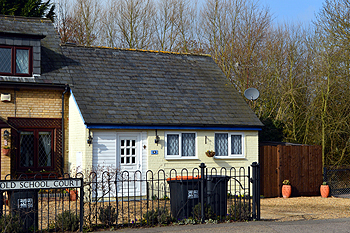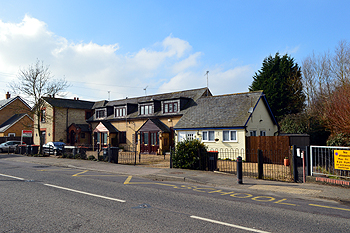Hockliffe School
The National Society was formed in 1811 to encourage the teaching of poor children along Anglican lines and the Charity Commissioners report of 1820 states that the trustees of the Francis West charity which funded the Hockliffe Charity School wished "to apply the funds of this charity towards supporting a national school, if such an institution can be established in the parish, as the benefit of the charity would, by such means, be extended to a much greater number of children." It took nearly a quarter of a century before this desire came to fruition. In 1844 a triangular piece of land fronting on to the Hockliffe to Woburn road, in the area originally part of Chalgrave parish which was transferred to Hockliffe in 1929, was given by Richard Thomas Gilpin of Hockliffe Grange as a site for a school for poor persons of Hockliffe and Chalgrave, to be united to the National Society. The school was to be managed by Gilpin (or subsequent proprietor of Hockliffe Grange), the rector of Hockliffe and Chalgrave, Millard Adams of Hockliffe, Abraham Mann of Chalgrave, Thomas Roberts of Chalgrave and Thomas Sayell of Chalgrave; as managers they had the right to appoint the schoolmaster and schoolmistress [P103/29/1].

6 Old School Court - a remainder of the old school February 2013
In 1846/7 the Church of England made an enquiry as to all its church schools. This was against the background of a new Whig government which championed secular education and the increasing importance of nonconformists, particularly Wesleyan Methodist, and Roman Catholics in providing schools. The Sunday School for Hockliffe-with-Chalgrave taught 62 boys and 52 girls, and the Day School 60 boys and 58 girls. It was noted that "it would be very desirable to have a master's house attached to the National School", and by 1853 plans had been drawn up for the building of a teacher's house.
In 1850 Rev. F. C. Cook reported on schooling for both boys and girls at Hockliffe. For the boys instruction and discipline appeared to be very good, the master was an intelligent and active teacher, and there were two pupil teachers; there was a good supply of books and apparatus, the desks and furniture were fair, and the school was in a satisfactory condition. The girls' school, with 45 pupils, was "efficiently conducted in four classes by mistress and pupil teacher, with occasional monitors", the mistress was "a very conscientious and successful teacher" who showed "great care and ingenuity"; books and apparatus were in good supply, although the "desks might be better arranged". The examination was very satisfactory except on religious subject which was attributed to "the reserve and timidity of the elder girls". In 1851 Rev. Cook found that the boys school was relying too much on the monitorial system and tat attendance was very irregular, varying from 24 to 50, which was attributed to the "increased demand for juvenile labour in the agricultural districts". The girls' school continued to be in a very satisfactory condition, reflecting "great credit on the mistress as well as managers". In 1853 Rev. Cook's assistant described the Hockliffe School building as providing for the 53 boys "a good-sized room, divided by sliding-doors; both divisions are quite full, and class-rooms are exceedingly desirable". The teacher, Mr Bryant, had only been there for five months but "he appears to be a diligent teacher, and I think, the school may be expected to do well". The buildings, equipment, playgournd and methods were the same for the 56 girls as for the boys. It appears the school may have continued the non-Conformist ethos of the Hockliffe Charity School, as the catechism was not taught except in the Sunday School [BHRS, 67].
The first Education Act was passed in 1870 (more correctly it was known as the Elementary Education Act). It was a milestone in the provision of education in Britain demonstrating central government's unequivocal support for education of all classes across the country. It also sought to secularise education by allowing the creation of School Boards. These were groups of representatives, elected by the local ratepayers and the Board had the powers to raise funds to form a local rate to support local education, build and run schools, pay the fees of the poorest children, make local school attendance compulsory between the ages of 5 and 13 and could even support local church schools, though in practice they replaced them, turning them into Board run schools (known as Board Schools). Naturally, and luckily for local historians, the Act required a questionnaire of local schools in 1870. In Hockliffe it was noted that Hockliffe National School was "without the district but available for it", and provided accommodation for 68 children.

Site of the old school February 2013
A land mark Education Act was passed in 1902, coming into effect in 1903. It disbanded the School Boards and gave day to day running of education to newly formed Local Education Authorities, usually the county council, as in Bedfordshire. The old Board Schools thus became Council Schools whilst the old National, British and other non-Board schools became known as Public Elementary Schools.
Bedfordshire & Luton Archives & Records Service has a scrapbook of cuttings of visits made to most Bedfordshire Schools by School Inspectors for a period from just before the First World War through the inter-war years [E/IN1/1]. In 1913 Hockliffe School was found to be "in a creditable state of efficiency. The work in both divisions of the school – Infants and older children – bears the stamp of care and thorough ness. Order and tone are very praiseworthy." In 1923 a new head teacher had recently taken charge and she showed "an evident desire to traise the school to a higher level". The children were well behaved and Standard VII "is quite an outstanding feature; its work is really creditable". However most of the rest of the work was more satisfactory than good. By 1927 the headmistress had improved the school to the point at which "good average work is the rule, not the exception" and in 1928 it was found to be a good school. In 1935 the school was conducted "with experienced thoroughness in teaching, in weekly tests, and in terminal examinations" and the headmistress was to be congratulated on the condition of the school.
In October 1937 it was stated that the school had recently become a Junior Mixed and Infants School. The roll had fallen from 70 to 51 as the senior children were now sent to Northfields in Dunstable. It had nevertheless continued a "very high standard of work" and "the conscientious direction of the Head Mistress in the very interesting but very different type of curriculum and approach which the change involved deserves recognition … All sides of the instruction given are sound and successful".
The third of the great Education Acts was that of 1944 which established the principle of County Primary Schools for children up to the age of 11, at which time they took an examination to determine the nature of the secondary school they would attend until they were 15, the most academically able going to grammar schools, the rest to secondary or secondary modern schools. The act also created two types of successor to the public elementary schools - the Voluntary Aided and Voluntary Controlled schools. Voluntary Aided schools, the category into which Hockliffe falls, are those in which the Local Education Authority funds the school but the governing body is independent, they are usually Anglican or Roman Catholic schools. Voluntary Controlled schools own their own buildings whilst the staff are employed directly by the governors.

Hockliffe Lower School February 2013
In the 1970s Bedfordshire County Council introduced comprehensive education, doing away with the 11+ examination and grammar schools and introducing a tier of school between the old County Primary and County Secondary Schools. Thus Lower Schools now taught children aged 4 to 9, Middle Schools from 9 to 13 and Upper Schools from 13 onwards. At this time Hockliffe County Primary became Hockliffe Lower School. In 2009 Bedfordshire County Council was abolished the new unitary Central Bedfordshire Council is now the Local Education Authority for Hockliffe.